The Guns of A Fully Stocked Armory
- November 20, 2015
- JR Grounds
- Gear Review
- gear, handguns, review, rifles, training
- 2 Comments
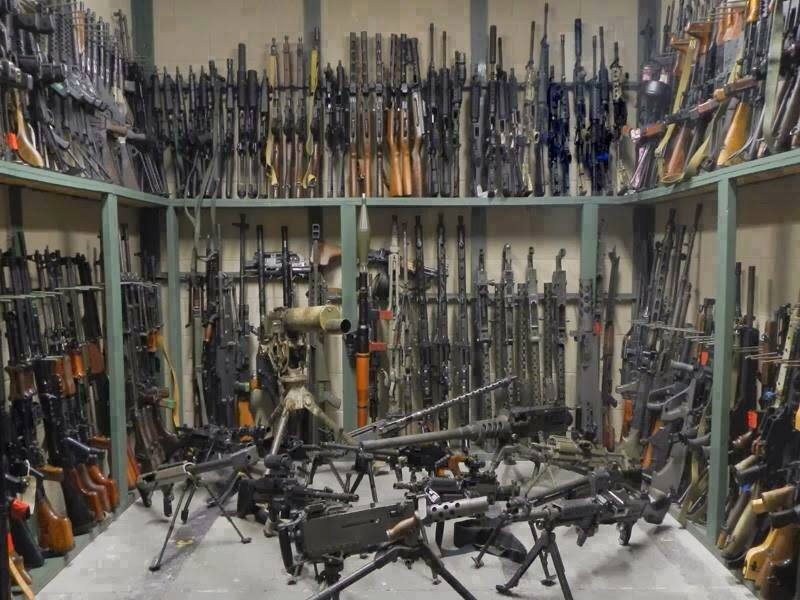
I’m often asked questions like,
“What guns should I own?”
…and if you search online, you’ll find plenty of articles on what guns to buy for the apocalypse. This article isn’t about that scenario.
I’ve also already done an article on choosing your EDC handgun, so this won’t be about that topic either.
Finally, this isn’t really an article about the best guns for home defense, although there are some overlapping elements inherent to the purpose of this collection.
This article will cover the collection you need, listed from the most important to the least important, in order to participate in just about any firearms course in any location. If your collection includes the items on this list, you can go to about 95% of the quality training companies out there and take 95% of their classes. By default, this collection touches on most of the guns necessary for a full defense situation, as well as including few offensive weapons.
HANDGUN Courses
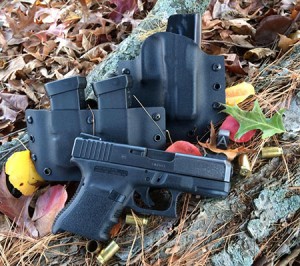 Obviously, you’ll need a quality handgun for these types of courses. If you want to know which one, refer to my article on choosing your first defensive handgun. I would recommend getting a full-size model, which would be a Glock 17, an XD or
Obviously, you’ll need a quality handgun for these types of courses. If you want to know which one, refer to my article on choosing your first defensive handgun. I would recommend getting a full-size model, which would be a Glock 17, an XD or
XDm, an M&P, or a VP9. In addition, you’ll need two high-quality holsters – one for strong side outside the waistband and one for concealed carry. My recommendation for OWB is one of the kydex holsters from Alpha Holsters or Kagel Dynamics. Do NOT get a Blackhawk SERPA holster, as many training locations do not allow them in their classes. For concealed carry, just take what you always carry (you do always carry, correct?). If you want a cheap, starter option, check out Alien Gear holsters, or for better quality, try Raven Concealment or G-Code INCOG. Accompanying your handgun, you will want at least 3 magazines, along with a way to secure those magazines to your body. For handgun courses, I always prefer an open top magazine holder, along the lines of the High Speed Gear belt mounts or the kydex versions from Alpha or Kagel.
RIFLE Courses
You’ll need a good AR rifle, 16” in length, set up for more high-speed use. The quality of your AR doesn’t matter as much as how you set it up. With that said, I will be doing an article soon on various AR manufacturers and who I like at each price point.
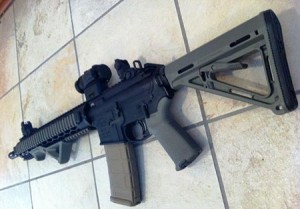 The two most important things on your AR for course training are your sites and your barrel length. You do not want anything over a 16” barrel length, although you can get by with 18” if that’s all you have. Under 16” is fine too, as long as you have an actual rifle and not one of the AR pistols. For optics, make sure you have a good set of open sites. If that’s all you have on your rifle, no problem, but if you run an actual optic, make sure you have a set of back-up irons, either static or flip-up. For the actual optic, a red dot or holographic is the way to go. Do not take some airsoft knock-off to the range – stay away from names like Barska, NcStar, Sitemark, etc. For just $130 you can get the Black Spider, which I reviewed in a previous article and for $450 you can get an EOTech or Aimpoint. And most importantly, just don’t put a long range scope on the gun you want to take to a bunch of fighting rifle courses.
The two most important things on your AR for course training are your sites and your barrel length. You do not want anything over a 16” barrel length, although you can get by with 18” if that’s all you have. Under 16” is fine too, as long as you have an actual rifle and not one of the AR pistols. For optics, make sure you have a good set of open sites. If that’s all you have on your rifle, no problem, but if you run an actual optic, make sure you have a set of back-up irons, either static or flip-up. For the actual optic, a red dot or holographic is the way to go. Do not take some airsoft knock-off to the range – stay away from names like Barska, NcStar, Sitemark, etc. For just $130 you can get the Black Spider, which I reviewed in a previous article and for $450 you can get an EOTech or Aimpoint. And most importantly, just don’t put a long range scope on the gun you want to take to a bunch of fighting rifle courses.
One last thing: you’re also going to want a sling. Arguments could be made for either two-point or single-point. Bottom line – just get a sling.
The only other two options you might want would be a vertical fore-grip (I prefer the angled versions) and perhaps a small flashlight. You will not want much else on your fighting rifle. You don’t need bipods, lasers, grenade launchers, bayonets, etc. For accessories, you will want at least 3 good magazines. The aluminum GI type mags are fine, but for around $12 each, you can upgrade to top-of-the-line Magpul magazines. You will also want some way to carry your AR mags, and again, you can contact Alpha or Kagel for a very budget-friendly option.
SHOTGUN Courses
 You’ll want a good, quality 12 gauge shotgun. For courses, you will find that you’re going to get the most “bang for your buck” with one of two models. I’m getting specific here, because they all function a bit differently, and you want to be able to run your gun like the instructor is explaining in class. My first choice would be a Remington 870 pump with the extended magazine tube. If you are going to buy one, look for the 870 Express Synthetic 7 round or 870 Express Tactical (different versions available). If you want a semi-auto and don’t mind paying extra, get either a Benelli M2 or M4. But honestly, unless you’re serious about taking a bunch of tactical shotgun courses, the 870 Express 7 round is going to be your best bet.
You’ll want a good, quality 12 gauge shotgun. For courses, you will find that you’re going to get the most “bang for your buck” with one of two models. I’m getting specific here, because they all function a bit differently, and you want to be able to run your gun like the instructor is explaining in class. My first choice would be a Remington 870 pump with the extended magazine tube. If you are going to buy one, look for the 870 Express Synthetic 7 round or 870 Express Tactical (different versions available). If you want a semi-auto and don’t mind paying extra, get either a Benelli M2 or M4. But honestly, unless you’re serious about taking a bunch of tactical shotgun courses, the 870 Express 7 round is going to be your best bet.
Now let’s talk about set-up. With regard to accessories, the only thing you really need is a side saddle shell carrier like the version available from MESA Tactical. For stocks, the simple solid rifle stock will work just fine. While there’s certainly nothing wrong with them if they’re what you have or want, you do not need the fancy collapsible or folding stocks.
Some courses will require you to have a sling, while others will not, but if you do purchase a sling, get a simple two-point. Optics aren’t highly necessary on a shotgun, but if you choose to put them on, make sure to use one of the micro-red dot versions with enough quality to tolerate the high recoil of the shotgun.
PRECISION RIFLE Courses
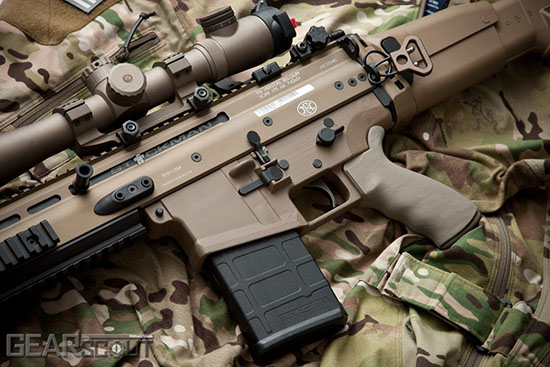 For a precision course, you have two options: you can either setup an AR or purchase a bolt action type of gun.
For a precision course, you have two options: you can either setup an AR or purchase a bolt action type of gun.
For most courses offered at 600 yards or less, you will find that the AR will work just fine and may even be superior due to its ability to complete quicker follow up shots. If you are going to set up a long range AR, the main changes will be in your barrel length and optics. A barrel length of 16” starts to get weak at those distances unless you use more expensive ammo. In my opinion, a better option is a heavier 18” barrel. In addition, you’ll want an optic that has some sort of magnification. Nikon makes a great scope for budget builds, with Leupold being the more expensive option. The Vortex options fall somewhere. Another thing you may want to consider is swapping out your rifle stock for something more designed for long range shooting. The Magpul PRS stock is fairly common in these courses. And finally, a bipod may be desired, but shooting on top of your backpack will work fine as well.
 If you want to go beyond 600 yards, you can either go to an AR platform shooting the .308 NATO round, go to a dedicated semi-auto for that round, or go to a bolt gun. I would steer clear of the .308 AR platform (known as the AR-10), since the lack of a mil-spec standard results in some serious issues when you want to replace parts. For the dedicated semi-auto, my two primary choices are the FN SCAR or the LWRC REPR. However, these are both rifles which easily push over $3,000 retail, and you will still need quality optics. For those not needing a semi-auto or those wanting something highly accurate without busting the budget, the bolt gun has been the standard precision rifle for many years. There are two very good options when looking for a bolt gun. The more budget friendly is the Savage Arms Model 10 – it’s a great gun that can shoot more accurately than most students. But for just a couple hundred more, the gold standard for law enforcement snipers is the Remington 700. For either of these platforms, the scopes mentioned above will work just fine. Finally, the only two accessories needed for a precision course are a mat to lie on (Condor makes a good one for cheap) and a bipod. Again, the bipod can be replaced by the use of a backpack. If you want to purchase additional accessories to make these courses easier, I would recommend purchasing a spotting scope (another article in the works).
If you want to go beyond 600 yards, you can either go to an AR platform shooting the .308 NATO round, go to a dedicated semi-auto for that round, or go to a bolt gun. I would steer clear of the .308 AR platform (known as the AR-10), since the lack of a mil-spec standard results in some serious issues when you want to replace parts. For the dedicated semi-auto, my two primary choices are the FN SCAR or the LWRC REPR. However, these are both rifles which easily push over $3,000 retail, and you will still need quality optics. For those not needing a semi-auto or those wanting something highly accurate without busting the budget, the bolt gun has been the standard precision rifle for many years. There are two very good options when looking for a bolt gun. The more budget friendly is the Savage Arms Model 10 – it’s a great gun that can shoot more accurately than most students. But for just a couple hundred more, the gold standard for law enforcement snipers is the Remington 700. For either of these platforms, the scopes mentioned above will work just fine. Finally, the only two accessories needed for a precision course are a mat to lie on (Condor makes a good one for cheap) and a bipod. Again, the bipod can be replaced by the use of a backpack. If you want to purchase additional accessories to make these courses easier, I would recommend purchasing a spotting scope (another article in the works).
SPECIALTY Courses
If you have the four weapons above, you can attend about 85% of the courses that are available out there. To get to 95% you will want to look at the following weapon systems:
Airsoft Handgun – Many training schools offer force-on-force training where in which training weapons are utilized. Some schools utilize sim-rounds, while others will use airsoft. Most of them will provide the weapon, but having one of your own that is similar to the pistol you carry has obvious training benefits. A high-quality airsoft will cost you around $100, but provide you with invaluable training opportunities. Look for gas-powered or CO2, and steer clear of the spring action models. Having an extra magazine, plenty of gas, plenty of ammo, and your own safety gear (mask and throat protection) will also make the courses more fulfilling.
AK – The AK rifle is the most prevalent weapon platform in the world. Even if you hate it, the chances of encountering one in an active shooter situation are fairly high. For that reason, we recommend people take at least a familiarization-level course. Some will allow you to borrow weapons, but purchasing is not overly expensive. Isaac Birch has written some great articles here covering this platform.
Pocket Pistol – These are your true backup weapons, and there are courses dedicated to using these weapons at close ranges. The most prevalent are the Ruger LCP, the M&P Bodyguard, and the Kel-Tec. Having a back-up is not a bad idea, and knowing how to properly run it is vital if you carry.
SMG – Sub-machine gun courses are fun, but not overly applicable within the civilian population. Weapons in this category include the UZI, the Kriss TDI, the H&K MP5, and a few others. Most of these weapons can be purchased in semi-auto versions, allowing you to attend the courses with relative ease.
Lever Action – Old West cowboys were excellent with their lever action rifles, and there are still a few schools who teach courses that cover these weapons. Again, they are primarily fun types of courses, but anytime you’re on the range you can pick up certain things that will be applicable in other situations.
There you have it: the complete armory for training. Start from the top of the list and work your way down. Get something fairly inexpensive and of good quality, and you can build on it later. Don’t be the student who shows up with toy parts, but you also don’t want to be the person who spends $10,000 on a weapon you don’t know how to run. Talk with other people in classes about what they have and what they like. See how their weapons perform. Ask to run a couple evolutions with their system. The best way to find what truly works for you is to try it. Thanks for reading – now get out there and train!
Links
http://www.remington.com/product-families/firearms/shotgun-families/pump-action-model-870.aspx
http://www.benelliusa.com/tactical-shotguns
http://mesatactical.com/products/category/side-mount-shell-carriers/
https://www.nikonsportoptics.com/en/nikon-products/riflescopes/m-223-4-16×42-bdc-600.html
http://www.vortexoptics.com/category/viper_pst_riflescopes
https://www.leupold.com/tactical/scopes/mark-4-lrt-riflescopes/
https://www.magpul.com/products/prs-precision-adjustable-stock-ar15-m16
http://www.savagearms.com/firearms/model/10FCPHS
http://www.remington.com/products/firearms/tactical/centerfire-tactical/model-700-sps-tactical.aspx
http://www.condoroutdoor.com/Condor-131.aspx
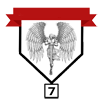
Great article! Since you added the airsoft pistol I would add the airsoft AR. I have found it useful practicing movement in the yard without worrying about where the round ends up.
Great article, and spot on with what should be in your arsenal to get started.